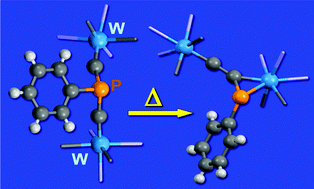Rearrangement of bis(alkylidynyl)phosphines to phospha-acyls†
Abstract
A range of bis(alkylidynyl)phosphines RP{C![[triple bond, length as m-dash]](https://www.rsc.org/images/entities/char_e002.gif) M(CO)2(Tp*)}2 (M = Mo, W; R = Cl, Ph, Cy; Tp* = hydrotris(dimethylpyrazolyl)borate) are obtained from the reactions of [M(
M(CO)2(Tp*)}2 (M = Mo, W; R = Cl, Ph, Cy; Tp* = hydrotris(dimethylpyrazolyl)borate) are obtained from the reactions of [M(![[triple bond, length as m-dash]](https://www.rsc.org/images/entities/char_e002.gif) CLi)(CO)2(Tp*)] with Cl2PR or alternatively via the palladium(0)-mediated reactions of [W(
CLi)(CO)2(Tp*)] with Cl2PR or alternatively via the palladium(0)-mediated reactions of [W(![[triple bond, length as m-dash]](https://www.rsc.org/images/entities/char_e002.gif) CBr)(CO)2(Tp*)] with RPH2 (R = Py, Cy). The complexes RP{C
CBr)(CO)2(Tp*)] with RPH2 (R = Py, Cy). The complexes RP{C![[triple bond, length as m-dash]](https://www.rsc.org/images/entities/char_e002.gif) W(CO)2(Tp*)}2 rearrange slowly (R = Cl) or on heating (R = Ph) to afford the isomeric phospha-acyls [W2(μ:η1-C;η2-C,P-CCPR)(CO)4(Tp*)2].
W(CO)2(Tp*)}2 rearrange slowly (R = Cl) or on heating (R = Ph) to afford the isomeric phospha-acyls [W2(μ:η1-C;η2-C,P-CCPR)(CO)4(Tp*)2].



 Please wait while we load your content...
Please wait while we load your content...